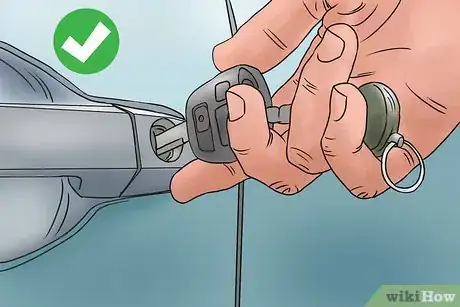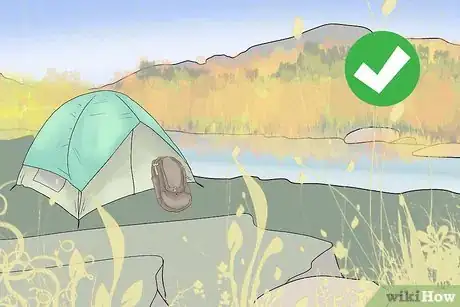This article was co-authored by Stef Katz. Stef Katz is a Travel Agent and the Founder of The Travel Superhero. She has helped clients enjoy convenience, access, personal attention, and ease in their travel planning for 6 years. Stef specializes in elevated social travel and finds ways to bring peace of mind to her travelers with open communication, genuine care, and professional support. She holds an Associate's Degree in Liberal Arts from Miami Dade College and a Bachelor's Degree in Marketing from the University of Florida, as well as numerous certifications with destinations, tour companies, and cruise lines in the travel industry.
There are 7 references cited in this article, which can be found at the bottom of the page.
This article has been viewed 19,036 times.
Canada is considered one of the most friendly countries in the world, and for smart travelers, it’s also budget-friendly! Planning your trip to Canada is fun and easy, and even if you’re on a tight budget, you can spend time in major cities, enjoy the outdoors, and experience the unique culture of the country.
Steps
Getting Around
-
1Opt to drive if you have a car. Driving is one of the cheapest and easiest ways to get around Canada. If you live close to Canada, you can drive your own car through customs and border control, or you can rent a car. Renting a car is more expensive, but is worth it if you are traveling long distances.[1]
- As a general rule of thumb, if you’re planning on traveling to 3 or more cities, it’s a good idea to rent a car because you will be traveling longer distances to get to your destinations.
- If you choose to drive around Canada, try to get gas on Native Reserves because it tends to be cheaper. The reserves are subject to fewer taxes which reduces the overall price of gas. First Nation reserves are marked by signs on the highways, or you can locate them on a map.[2]
-
2Take the Megabus from city to city. Like in the U.S., Canada has a Megabus system that runs across the country and also makes stops in cities along the border in the U.S. You can travel from Toronto to Montreal, and tickets are extremely cheap, especially when booked in advance.[3]
- Be aware that the Megabus tends to be slower and run late, so it may not be the most efficient option if you have a tight schedule.
Advertisement -
3Fly to Canada with a budget airline. Airlines like Flair and WOW are offering low-cost flights within the U.S. and Canada between major cities for around $100. Since they’re budget airlines, they don’t include things like checked bags, but this is a great option for light travelers who need an inexpensive way to get to Canada.[4]
- Budget airlines are able to offer low-cost tickets by eliminating the traditional frills of air travel, like checked baggage and in-flight snacks and drinks. Anything considered an amenity comes with a fee from the airline.
- If you don’t live near a major city, consider driving to the nearest major airport to save on the cost of an additional flight.
- If you’re located outside of the U.S. and Canada, WOW airlines offers flights from most European cities. Alternatively, you can book a longer flight with a traditional airline, then fly between cities on a budget airline.
-
4Travel by train across Canada and along the coasts. Canada has an extensive rail system, and train travel is one of the most cost-friendly ways to see the country. Tickets for economy class start as low as $25 CAD for shorter distances, and there are packages for longer distances as well.[5]
- You can select to travel in economy class, which secures you a seat; business or touring class, which provides access to refreshments and larger seats; and sleeper class, which gives you a bed for overnight travel.[6]
Selecting Your Lodging
-
1Use home sharing services like Airbnb. These are very popular and inexpensive ways to stay the night in many large cities like Toronto, Montreal, Vancouver, and Ottawa. Look for shared rooms rather than entire homes, because sharing the spaces tends to be cheaper.[7]
- Using a website like Airbnb gives you the security of background verification for hosts. Craigslist and Facebook groups don’t provide you with this, but they can be less expensive because they cut out the middleman.
- Prices will vary based on location and the number of people looking to stay at the home. Most inexpensive Airbnbs can comfortably sleep 2 people at a time.
-
2Consider couchsurfing if you’re an adventurous traveler. Some people will open their homes to backpackers or tourists to sleep on their couch for a night or two for a small fee. Check sites like Craigslist or couchsurfing.com, and look at local Facebook groups to see if there are any safe couchsurfing locations available in that area.[8]
- A drawback of couchsurfing is that you normally can’t reserve the couch in advance, so you risk not having a place to stay if an arrangement falls through. Be prepared with extra funds for a hotel in case this happens.
- If you’re considering couchsurfing, be sure to clarify the arrangement with the host. Try to set up a video or phone call before you arrive to discuss your stay with them and verify that they are who they say they are.
-
3Camp at one of the beautiful campgrounds during the spring and summer. Camping is extremely budget-friendly and there are a variety of locations to set up your tent all around Canada. Some locations require you to submit a permit and small fee for using the campgrounds, so make sure you check the ground’s website beforehand.[9]
- If you’ve never gone camping before, make sure you have a sturdy tent, enough food, a portable cooktop, flashlights and sleeping bags. Always do a trial run of your campsite at home before embarking on your adventure!
- If you haven’t scoped out your campground in advance, look for signs along roadways that mark designated camping areas, provincial parks, or national parks. You can also consult a map to find these areas ahead of time.
- Camping might be less viable in the winter, especially for less-experienced campers. Don’t attempt to camp in the snow unless you’ve done it before, as it can be dangerous for your health without the proper protection.
-
4Stay at hostels if you need an inexpensive and no-frills place to rest. Hostels are abundant in popular areas across Canada, including cities like Montreal, Ottawa, Banff, and Vancouver. Most hostels have shared bathrooms and kitchen areas, and might have shared bedrooms as well. To find a hostel, you can search “Hostels in ____,” and get the contact and booking information.[10]
- The price of the hostel will vary based on the location and time of year. In the off-season, you can get great deals on hostels, even in downtown city centers. Keep in mind that in cities like Vancouver, which is popular in the winter, the off-season is the summer.
- Hostels can be great places for making connections with other travelers and getting tips from locals. Don’t be afraid to ask around for suggestions, especially if you’re looking for fellow budget-conscious travelers!
Having Fun
-
1Take free walking tours of the major cities. Canada is an extremely historical country, and most cities offer free tours of the downtown and historically relevant areas. Check the local tourism websites for times and locations of tours, and do one on your first day in the city. It’ll help you learn the layout of the city and let you see some of the major landmarks![11]
- If you’re planning on taking a tour, make sure you wear your walking shoes and dress for the weather! They can be long, sometimes up to 2-3 hours, and the weather in some cities can change unexpectedly.
-
2Go to music, art, and food festivals. Especially during the summer, most large cities have a variety of outdoor festivals with free entrance. Take advantage of the opportunity to see local artists and sample Canadian cuisine![12]
- If you’re traveling in the winter, don’t worry! Since Canada has long winters, they also have many cold weather festivals like the Igloofest in Montreal, WinterCity in Toronto, Festival du Voyager in Winnipeg, and Winterlude in Ottawa.[13]
-
3Buy food from street vendors and local grocery stores. This is one of the best ways to get a taste of the local fare while on a budget. Street vendors in Canada are normally very reputable and offer cheap options for a quick bite for lunch or a snack. Look for vendors and food trucks with long lines, as those tend to be the ones popular with locals![14]
- Canada is famous for the popular dish poutine, which is a plate of french fries with gravy and cheese curds. Many street vendors offer a variation of this dish, plus meats like hot dogs, sausage, and even veggie burgers!
-
4Get outside and take advantage of Canada’s vast wildlife. Canada is known for its beautiful forests, lakes, and trails. National Parks and Grasslands are extremely popular and have many free trails for hiking and biking, as well as lakes and rivers for kayaking and canoeing.[15]
- In the winter, you can go skiing, or rent a pair of snowshoes or cross-country skis for a low-cost excursion on one of the many public trails that remain open during the cold weather.
- In the cities, biking is a great and low-cost way to get around quickly. You can rent bikes for a few dollars a day or based on an hourly rate. Just be sure to return them when you’re finished!
-
5Visit museums, art galleries, and universities. Art and history are extremely important cultural aspects of life in Canada, so there are many free or low-cost museums and galleries to visit. Additionally, most universities offer free tours of their campuses, some of which include small museums or historical landmarks.[16]
- Some museums operate on a donation-basis, but it’s appropriate to give a few dollars to make sure the museum is compensated for their services. At these locations, it’s up to you to decide what’s a fair price!
-
6Use coupons or deal-finding websites. Sites like LivingSocial and Groupon sometimes offer discounts on local attractions and experiences based on your location. Download the apps and search for deals in the cities that you’ll be going to. Buying ahead secures your ticket and can result in extremely discounted rates for concerts, outdoor excursions, plays, and more![17]
- Sometimes new businesses will offer coupons on these apps to get people to try out their product. Keep your eyes out for new and fun experiences that might not be listed on popular travel blogs just yet!
- Think about what you want to experience in Canada and how you would like to experience it.
- Decide your dates of travel.
- Talk to your travel agent to find out whether you can get what you want in your budget or the closest you can get to it.
Warnings
- If you’re traveling alone, always be aware of your surroundings and walk or bike on well-lit streets. Make sure a friend or loved one knows your location and can contact you if necessary!⧼thumbs_response⧽
- If you’re traveling from the U.S. or another country, you’ll need a passport to be able to get into Canada. Make sure your passport is valid and you have the proper visas to enter the country.⧼thumbs_response⧽
References
- ↑ https://www.nomadicmatt.com/travel-guides/canada-travel-tips/#tips
- ↑ https://www.nomadicmatt.com/travel-guides/canada-travel-tips/#tips
- ↑ https://www.nomadicmatt.com/travel-guides/canada-travel-tips/#tips
- ↑ https://globalnews.ca/news/3829068/low-cost-airlines-canada/
- ↑ http://www.bootsnall.com/articles/16-03/how-to-travel-across-canada-by-train-on-a-budget.html
- ↑ http://www.bootsnall.com/articles/16-03/how-to-travel-across-canada-by-train-on-a-budget.html
- ↑ https://www.nomadicmatt.com/travel-guides/canada-travel-tips/#tips
- ↑ https://www.nomadicmatt.com/travel-guides/canada-travel-tips/#tips
- ↑ https://www.freshoffthegrid.com/how-to-find-free-camping-usa-canada/
- ↑ https://www.hayleyonholiday.com/solo-budget-travel-canadian-rockies/
- ↑ https://www.nomadicmatt.com/travel-guides/canada-travel-tips/#tips
- ↑ https://www.nomadicmatt.com/travel-guides/canada-travel-tips/#tips
- ↑ https://us-keepexploring.canada.travel/things-to-do/festivals-and-events-heat-up-winter
- ↑ https://www.nomadicmatt.com/travel-guides/canada-travel-tips/#tips
- ↑ https://www.freshoffthegrid.com/how-to-find-free-camping-usa-canada/
- ↑ https://www.tourismvancouver.com/activities/free-almost-free/25-free-things-to-do/
- ↑ https://www.nomadicmatt.com/travel-guides/canada-travel-tips/#tips



































































